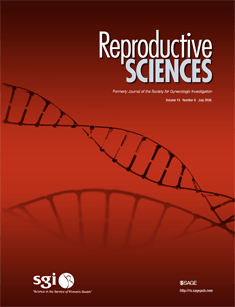
Reproductive Sciences
Scope & Guideline
Advancing Knowledge in Reproductive Health
Introduction
Aims and Scopes
- Reproductive Physiology and Endocrinology:
The journal publishes studies on hormonal regulation, reproductive cycles, and physiological processes involved in reproduction across various species. - Assisted Reproductive Technologies (ART):
Research on ART techniques such as artificial insemination, in vitro fertilization, and embryo transfer, which are critical for improving reproductive outcomes in livestock and endangered species. - Semen Quality and Cryopreservation:
Articles often focus on methodologies to assess and improve semen quality, including the effects of different cryopreservation protocols and extenders on sperm viability. - Impact of Nutrition and Environmental Factors:
The journal addresses how dietary components, environmental stressors, and management practices influence reproductive health and success. - Genetics and Reproductive Performance:
Research on genetic factors affecting reproductive traits, including genetic selection and molecular biology approaches to understand fertility. - Embryonic Development and Maternal-Fetal Interactions:
Studies exploring the early stages of embryonic development, maternal recognition of pregnancy, and factors influencing fetal growth and development. - Comparative Reproductive Biology:
The journal includes comparative studies that highlight reproductive mechanisms across different species, aiding in the understanding of evolutionary adaptations.
Trending and Emerging
- Molecular and Cellular Mechanisms of Reproduction:
There is a growing emphasis on understanding the molecular pathways and cellular interactions that regulate reproductive processes, including gene expression and epigenetic modifications. - Use of Antioxidants in Reproductive Health:
Research exploring the role of antioxidants in improving semen quality and mitigating oxidative stress during reproductive procedures is increasingly popular, indicating a focus on enhancing reproductive outcomes. - Impact of Environmental Stressors:
Studies examining the effects of environmental factors such as heat stress, pollution, and nutritional challenges on reproductive performance are on the rise, reflecting concerns over climate change and animal welfare. - Innovations in Cryopreservation Techniques:
The development of new cryopreservation methods, including the use of novel extenders and additives to improve post-thaw sperm quality, is a trending topic in the journal. - Microbiome Influence on Reproductive Health:
Emerging research is focusing on the role of the microbiome in reproductive health, particularly how microbial communities affect fertility and reproductive success. - Application of Omics Technologies:
The integration of genomics, proteomics, and metabolomics in reproductive research is gaining momentum, facilitating a more comprehensive understanding of reproductive biology.
Declining or Waning
- Traditional Breeding Techniques:
Research focusing on conventional breeding methods has decreased as more emphasis is placed on advanced reproductive technologies and genetic approaches. - Invasive Surgical Techniques:
There has been a noticeable reduction in studies employing invasive surgical methods for reproductive interventions, likely due to the growing preference for non-invasive or less invasive techniques. - Basic Reproductive Anatomy Studies:
The exploration of basic reproductive anatomy has waned, as the field shifts towards more functional and molecular studies that provide insights into mechanisms rather than mere anatomical descriptions. - Studies on Non-Domestic Species:
While still present, research concerning the reproductive science of non-domestic or less commonly studied species has decreased in favor of more commercially relevant livestock and companion animals. - Historical Perspectives on Reproductive Technologies:
There has been a decline in publications that review historical technologies and methods in reproductive science, as the focus shifts towards cutting-edge advancements and current challenges.
Similar Journals
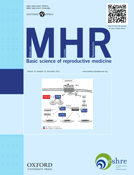
MOLECULAR HUMAN REPRODUCTION
Transforming Reproductive Health through Rigorous ResearchMOLECULAR HUMAN REPRODUCTION, published by Oxford University Press, is a pivotal journal dedicated to advancing the field of reproductive biology. Since its inception in 1995, the journal has been recognized for its rigorous peer-reviewed research and substantial contributions to the understanding of molecular mechanisms underlying human reproduction. With an impressive impact factor and ranked within the top tiers (Q1 and Q2) across diverse categories including Embryology, Obstetrics and Gynecology, and Reproductive Medicine, it stands as an essential resource for researchers, healthcare professionals, and students alike. The journal aims to publish cutting-edge research that explores the complexities of human reproduction at the molecular and cellular levels, fostering a deeper understanding that can be translated into clinical practice. Although it currently operates under a subscription model, the valuable insights and groundbreaking findings featured within its pages continue to influence the trajectory of reproductive health research globally. Located in the heart of Oxford, United Kingdom, the journal remains committed to addressing vital challenges in the field and promoting innovative scientific dialogue.

Reproduction and Fertility
Advancing insights in reproductive health.Reproduction and Fertility is a premier academic journal published by BIOSCIENTIFICA LTD, dedicated to advancing knowledge in the fields of reproductive sciences, obstetrics, gynecology, and related areas. Established with a focus on delivering high-quality research, this journal has quickly ascended in prominence, achieving a commendable Q2 ranking in multiple categories, including Embryology, Obstetrics and Gynecology, Reproductive Medicine, and Urology, as of 2023. With an E-ISSN of 2633-8386, Reproduction and Fertility aims to provide a valuable platform for researchers, professionals, and students alike, offering insights into the latest discoveries and innovations in reproductive health. Although currently not an open-access journal, it remains committed to disseminating important findings that can influence clinical practices and policy-making worldwide. Operating from its headquarters in Bristol, United Kingdom, the journal serves as an essential resource for anyone invested in understanding and improving reproductive health outcomes through rigorous academic research.
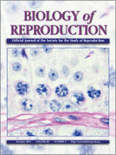
BIOLOGY OF REPRODUCTION
Driving Discoveries in Reproductive MedicineBIOLOGY OF REPRODUCTION is a premier journal published by Oxford University Press Inc, dedicated to advancing research in the fields of reproductive biology, cell biology, and reproductive medicine. With an impressive impact factor and a strong ranking as Q1 in reproductive medicine and miscellaneous medicine, as well as Q2 in cell biology, this journal offers a vital platform for disseminating innovative findings and pivotal studies that shape our understanding of reproductive processes. Since its inception in 1969, BIOLOGY OF REPRODUCTION has become a key resource for scientists, clinicians, and students alike, providing insights that drive the future of reproductive health and research. Although not an open-access publication, it remains a respected authority, reflecting a commitment to high-quality peer-reviewed articles. The journal's comprehensive scope includes molecular and cellular aspects of reproduction, reproductive health, and associated technologies, making it indispensable for professionals looking to stay at the forefront of breakthroughs within the field.

Reproductive and Developmental Medicine
Connecting scholars to elevate reproductive and developmental medicine.Reproductive and Developmental Medicine is a pioneering open-access journal dedicated to advancing knowledge in the fields of reproductive medicine and developmental biology. Published by LIPPINCOTT WILLIAMS & WILKINS, the journal serves as a platform for researchers, clinicians, and graduate students alike, fostering collaboration and dissemination of innovative research findings. With an ISSN of 2096-2924 and E-ISSN 2589-8728, it has established a significant presence in the academic community since its inception in 2017. The journal is indexed in Scopus and achieved a category quartile ranking of Q3 in Obstetrics and Gynecology and Q4 in Reproductive Medicine as of 2023, highlighting its importance as a resource for cutting-edge studies and reviews in these vital areas. The journal's open-access model ensures that research is readily available to scholars and practitioners worldwide, thus enhancing the global discourse in reproductive health and development. This makes Reproductive and Developmental Medicine an invaluable resource for those dedicated to improving outcomes in obstetrics, gynecology, and reproductive health.
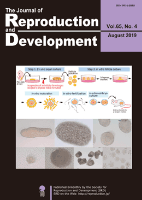
JOURNAL OF REPRODUCTION AND DEVELOPMENT
Empowering research in reproduction and development.JOURNAL OF REPRODUCTION AND DEVELOPMENT, published by the SOCIETY REPRODUCTION & DEVELOPMENT-SRD in Japan, is a leading peer-reviewed journal dedicated to advancing the field of reproduction and development in animal sciences. With a notable impact factor reflected in its prestigious Q1 Quartile ranking in Animal Science and Zoology, the journal aims to disseminate cutting-edge research that explores the complexities of reproductive biology, developmental processes, and their implications for agriculture and biodiversity. This journal invites contributions that span multidisciplinary interests, thereby facilitating the integration of scientific knowledge and practical applications. Researchers, professionals, and students can benefit from the insights shared within its pages, as it strives to foster collaboration and innovation in the field. The journal’s comprehensive scope and esteemed reputation, underscored by its Scopus rank of #115 out of 490 in the category, make it an invaluable resource for anyone invested in the study of reproduction and development.
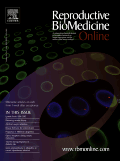
REPRODUCTIVE BIOMEDICINE ONLINE
Exploring the frontiers of reproductive biology and medicine.Reproductive Biomedicine Online, published by Elsevier, is a leading peer-reviewed journal that has established itself as a pivotal resource in the fields of Developmental Biology, Obstetrics and Gynecology, and Reproductive Medicine. With an impressive Impact Factor and a Q1 ranking in its respective disciplines as of 2023, this journal provides a platform for innovative research and comprehensive reviews that contribute to advancements in reproductive healthcare. The journal boasts rigorous Scopus rankings, placing it within the top tiers of its categories, which underscores its significance in shaping contemporary biomedical inquiry. Although not open access, it remains widely accessible through institutional subscriptions, making its wealth of knowledge available to researchers, clinicians, and students alike. Since its inception in 2000, Reproductive Biomedicine Online has been committed to fostering a deeper understanding of reproductive processes and biomedicine, ensuring that its content remains relevant and impactful in addressing challenges in reproductive health, thereby championing exceptional scientific discourse.
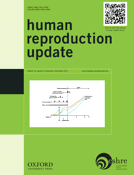
HUMAN REPRODUCTION UPDATE
Shaping the Future of Reproductive MedicineHUMAN REPRODUCTION UPDATE, published by Oxford University Press, stands as a leading journal in the fields of Obstetrics and Gynecology and Reproductive Medicine. With an impressive Q1 ranking in both categories according to the 2023 category quartiles and a significant Scopus rank, it is recognized as one of the top journals globally in these disciplines, catering to the most relevant and cutting-edge research. The journal has been a crucial platform for disseminating vital findings and reviews from 1995 to 2024, contributing to advancements in human reproductive health. With its focus on publishing high-quality, peer-reviewed articles, it serves as an essential resource for researchers, healthcare professionals, and students seeking the latest insights and developments in reproductive science. As the journal aims to foster informed discussions and encourage further research, it remains committed to shaping the future of reproductive health and medicine.
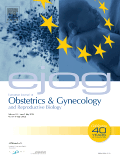
European Journal of Obstetrics & Gynecology and Reproductive Biology
Unveiling the Science of Reproductive BiologyWelcome to the European Journal of Obstetrics & Gynecology and Reproductive Biology, a premier publication dedicated to advancing the fields of obstetrics, gynecology, and reproductive medicine. Published by Elsevier, this journal has been a vital resource since its inception in 1971, continuing to provide high-quality, peer-reviewed research through 2024 and beyond. With an impressive impact factor and recognized in the Q2 quartile for both obstetrics and gynecology, as well as reproductive medicine, it ranks among the top journals in its field, being positioned at #59 out of 209 in Obstetrics and Gynecology and #29 out of 90 in Reproductive Medicine. Though not currently an Open Access journal, it remains committed to disseminating valuable findings to enhance clinical practice and facilitate further research. Researchers, professionals, and students can expect insightful articles, comprehensive reviews, and pioneering studies that significantly impact women's health and reproductive biology.

International Journal of Fertility & Sterility
Unlocking New Possibilities in Fertility ScienceThe International Journal of Fertility & Sterility, published by ROYAN Institute, is a leading academic platform dedicated to advancing knowledge in the fields of obstetrics, gynecology, and reproductive medicine. With an ISSN of 2008-076X and an E-ISSN of 2008-0778, this Open Access journal has been making significant contributions to the scientific community since its inception in 2007. Based in Tehran, Iran, the journal showcases rigorous research and promotes interdisciplinary collaboration, addressing critical topics related to fertility, sterility, and reproductive health. As of 2023, it holds an impressive Q2 ranking in Obstetrics and Gynecology and a Q3 ranking in Reproductive Medicine, underscoring its relevance and impact in the academic sphere, with Scopus ranks placing it at #67 in Obstetrics and Gynecology and #32 in Reproductive Medicine. The journal's commitment to accessibility and quality is reflected in its global readership, making it an essential resource for researchers, healthcare professionals, and students seeking to enhance their understanding of fertility issues and reproductive technologies.
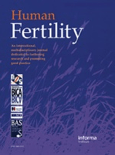
Human Fertility
Advancing the Science of Reproductive HealthHuman Fertility, published by Taylor & Francis Ltd, is a key academic journal that serves the dynamic fields of medicine, obstetrics and gynecology, and reproductive medicine. Established in 1998 and with converged content extending to 2024, the journal holds a notable Q2 ranking in its respective categories, highlighting its influence and scholarly contributions to current research and practice. With an ISSN of 1464-7273 and an E-ISSN of 1742-8149, it rigorously disseminates studies, reviews, and advancements in human fertility, particularly emphasizing evidence-based practices and innovative techniques. Despite its traditional subscription model, the journal remains vital for researchers, healthcare professionals, and students seeking to foster advancements in reproductive health. Its articles are pivotal in addressing the multifaceted challenges faced in reproductive health and guiding future research trajectories.